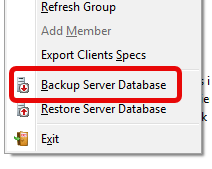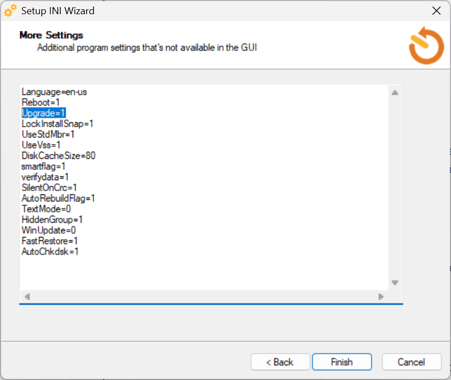How to upgrade the Reboot Restore client
applies to Reboot Restore Enterprise/Standard v13.1 and up
NOTE: This process will delete all your current snapshots (LGK and start baseline). The system's current state will then be set as the start baseline
You will also need a version 13 license key (Enterprise/Standard) if you're upgrading from an older version (i.e. version 12, 11,etc) to fully activate the upgraded client install. Users with active maintenance package can contact us to upgrade their license to version 13.x.
This upgrade process keeps your current Reboot Restore client settings (restore settings, remote management, etc.).
Standalone Upgrade
- Download the latest version
- Extract the downloaded ZIP file
- Go to Start > search for "command prompt" > run as Administrator

- From the command prompt, navigate to the client installer folder
- Run the command
setup.exe /upgrade /autoinstall
Sample below

- A dialog will show progress and automatically reboots the PC

- Once the PC has restarted, the Reboot Restore has been successfully upgraded. If you used this method on an older client version (v12.x, v11.x, etc.) you will need to activate with a purchased key.
Upgrade via the Endpoint Manager Console
- Download the latest version on the Endpoint Manager workstation/Server
- Extract the downloaded ZIP file
-
- Upgrade the EndPoint Manager first - navigate to the Endpoint Manager installer and run Setup.exe. The following dialog will be presented, click on OK.

- Upgrade the EndPoint Manager first - navigate to the Endpoint Manager installer and run Setup.exe. The following dialog will be presented, click on OK.
WARNING: Endpoint Manager user accounts, tasks and custom groups may not carry over with the above process.
For best practices, make sure to Backup Server Database first before running the in-line upgrade for the Endpoint Manager.
Open and login to the Endpoint Manager > go to Endpoint Manager > Backup Server Database
Update the workstations via the EndPoint Manager
- From the Endpoint Manager, select the connected clients or the group you want to upgrade
- Click on Clients > Deploy Options > Send Files
- You can also right click on the group or selected workstations

- Select files or folder to send to the clients: Click Browse > select the Reboot Restore client installer folder
- this may be in your Downloads folder
- Target director on the clients: C:\Receive - this is the location on your protected workstations where the EndPoint Manager will deploy the installation file.
- Run this program on the clients after sending the files: Click the down arrow and select Setup.exe and add the following switches /upgrade /autoinstall after setup.exe. The command should look like this:
C:\Receive\Reboot Restore Client\Setup.exe /upgrade /autoinstall
- Toggle on "Run as localsystem"
- Click OK and a progress dialog window will appear (similar to this one)

This upgrade process will remove the currently installed version of Reboot Restore and complete the upgrade process automatically. Once the Clients reconnect to the EndPoint Manager, you can confirm they are on the latest version by adding the "Build #" column to the EndPoint Manager. The build number should match the EndPoint Manager's under Help > About.
If you're using this method on older Client versions (v12.x, v11.x, etc.) you will need to activate the clients with a purchased v13 key.Additional Upgrade Options/Notes
If you already have a new version key and want to include this new key in your upgrade process then the process is a bit different (Enterprise only)
Prep your installer
- Using the Setup INI Wizard utility (located under Deployment Tools), create a custom setup.ini file. Insert your new license key when prompted
- In the More Settings step, look for the upgrade=0 switch and change it to upgrade =1

- Save the custom setup.ini file and copy to/overwrite the existing setup.ini file
Command line Install
- Open the command prompt as an Administrator
- Navigate to the client installer folder and run the command below
setup.exe /s
- If you get a UAC (User Access Control) prompt, click OK
- The dialog box below should show up and automatically reboot the PC

Upgrade via the Endpoint Manager
Make sure the EndPoint Manager is already upgraded to the latest version
- Select the connected client or group you want to upgrade
- Click on Clients > Deploy Options > Send Files (or right-click on the selected clients or group)

- Select files or folder to send to the clients: Click Browse > select the Reboot Restore client installer folder
- this may be in your Downloads folder
- Target director on the clients: C:\Receive - this is the location on your protected workstations where the EndPoint Manager will deploy the installation file.
- Run this program on the clients after sending the files: Click the down arrow and select Setup.exe and add the following switches /s after setup.exe. The command should look like this:
C:\Receive\Reboot Restore Client\Setup.exe /s
- Toggle on "Run as localsystem"
- Click OK and a progress dialog window will appear
This upgrade process will remove the currently installed version of Reboot Restore and complete the upgrade process automatically. Once the Clients reconnect to the EndPoint Manager, you can confirm they are on the latest version by adding the "Build #" column to the EndPoint Manager. The build number should match the EndPoint Manager's under Help > About.
Do you need additional help? Contact us by submitting a ticket.